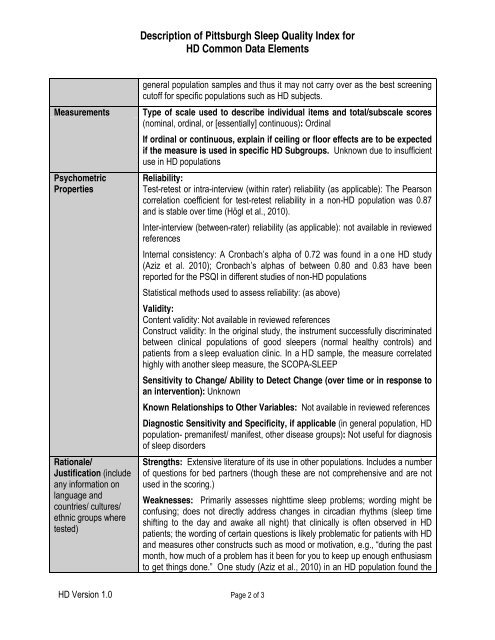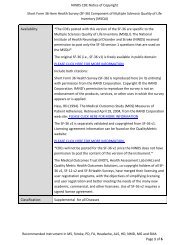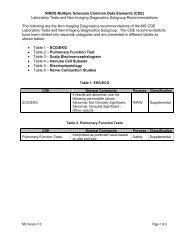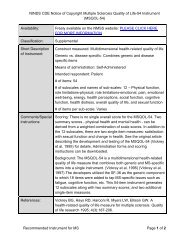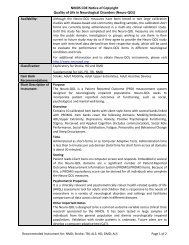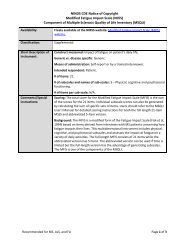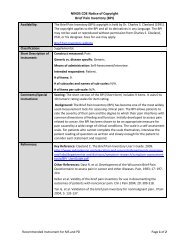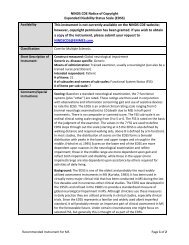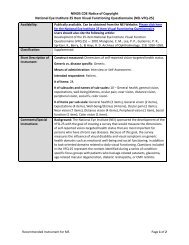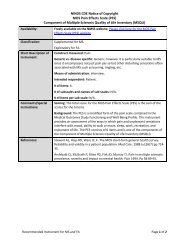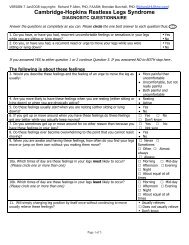NINDS CDE Huntington's Disease Behavioral Psychology Subgroup ...
NINDS CDE Huntington's Disease Behavioral Psychology Subgroup ...
NINDS CDE Huntington's Disease Behavioral Psychology Subgroup ...
Create successful ePaper yourself
Turn your PDF publications into a flip-book with our unique Google optimized e-Paper software.
Description of Pittsburgh Sleep Quality Index forHD Common Data ElementsMeasurementsPsychometricPropertiesRationale/Justification (includeany information onlanguage andcountries/ cultures/ethnic groups wheretested)general population samples and thus it may not carry over as the best screeningcutoff for specific populations such as HD subjects.Type of scale used to describe individual items and total/subscale scores(nominal, ordinal, or [essentially] continuous): OrdinalIf ordinal or continuous, explain if ceiling or floor effects are to be expectedif the measure is used in specific HD <strong>Subgroup</strong>s. Unknown due to insufficientuse in HD populationsReliability:Test-retest or intra-interview (within rater) reliability (as applicable): The Pearsoncorrelation coefficient for test-retest reliability in a non-HD population was 0.87and is stable over time (Högl et al., 2010).Inter-interview (between-rater) reliability (as applicable): not available in reviewedreferencesInternal consistency: A Cronbach’s alpha of 0.72 was found in a o ne HD study(Aziz et al. 2010); Cronbach’s alphas of between 0.80 and 0.83 have beenreported for the PSQI in different studies of non-HD populationsStatistical methods used to assess reliability: (as above)Validity:Content validity: Not available in reviewed referencesConstruct validity: In the original study, the instrument successfully discriminatedbetween clinical populations of good sleepers (normal healthy controls) andpatients from a sleep evaluation clinic. In a HD sample, the measure correlatedhighly with another sleep measure, the SCOPA-SLEEPSensitivity to Change/ Ability to Detect Change (over time or in response toan intervention): UnknownKnown Relationships to Other Variables: Not available in reviewed referencesDiagnostic Sensitivity and Specificity, if applicable (in general population, HDpopulation- premanifest/ manifest, other disease groups): Not useful for diagnosisof sleep disordersStrengths: Extensive literature of its use in other populations. Includes a numberof questions for bed partners (though these are not comprehensive and are notused in the scoring.)Weaknesses: Primarily assesses nighttime sleep problems; wording might beconfusing; does not directly address changes in circadian rhythms (sleep timeshifting to the day and awake all night) that clinically is often observed in HDpatients; the wording of certain questions is likely problematic for patients with HDand measures other constructs such as mood or motivation, e.g., “during the pastmonth, how much of a problem has it been for you to keep up enough enthusiasmto get things done.” One study (Aziz et al., 2010) in an HD population found theHD Version 1.0 Page 2 of 3


